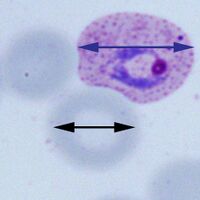Red cell size and shape: P.vivax
From haematologyetc.co.uk
Navigation
Go Back
| How is red cell size and shape affected as P.vivax develops?
This species tend to have the largest red cell size that becomes evident at quite and early stage; the typical shape is quite irregular fimbriation is not (generally) seen.
Trophozoites of P.vivax cause increase in size and distortion of red cells as the parasites mature. Here, the the early trophozoite (A) is enlarged but still retains a relatively undistorted elongated shape (similar to P.ovale); however the late form (B) is has a very irregular shape (note that unlike P.ovale the red cell is not fimbriated). |

